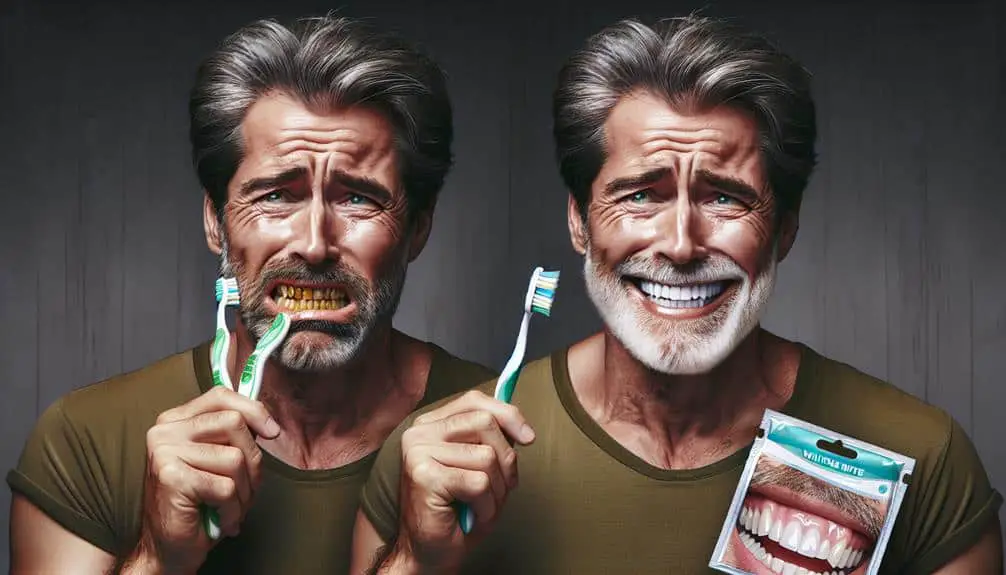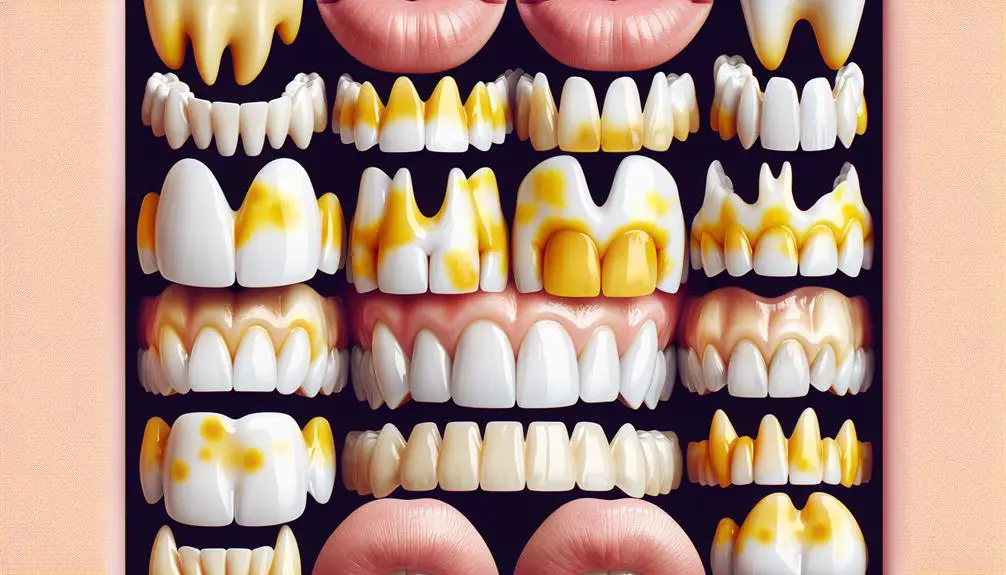To treat medication stain discoloration, consider causes like tetracycline and common medications that impact tooth enamel. Understand the types of stains – extrinsic, intrinsic, or combined – to choose effective removal techniques. Try whitening options such as baking soda, hydrogen peroxide, or natural remedies like oil pulling. Prevent stains by maintaining proactive oral hygiene habits and seeking professional whitening treatments like in-office bleaching or laser whitening for deep-seated stains. Consult with your dentist for whitening recommendations. Implement these tips to manage medication stain discoloration effectively.
Key Points
- Consider professional whitening treatments for deep-seated stains.
- Use whitening options like baking soda and hydrogen peroxide.
- Practice proactive oral hygiene to prevent discoloration.
- Explore natural remedies such as oil pulling with coconut oil.
- Consult a dentist before trying any whitening treatments.
Causes of Medication Stain Discoloration
When medications such as tetracycline or iron supplements interact with the surface of your teeth, they can cause stain discoloration. Common medications, especially those like antihistamines, antipsychotics, and high blood pressure drugs, are known to lead to staining. These medications can affect the enamel of your teeth, leading to discoloration over time. To address this issue, stain removal techniques become vital.
Stain removal procedures can vary based on the severity of the discoloration. For mild cases, regular dental cleanings and good oral hygiene practices can help reduce the stains caused by medications. However, for more stubborn stains, professional teeth whitening treatments or veneers may be necessary. It's essential to consult with your dentist to determine the most suitable course of action for your specific situation.
Understanding the common medications that can contribute to teeth staining is the first step in effectively managing and treating medication stain discoloration. By being proactive and seeking appropriate dental care, you can maintain a bright and healthy smile despite the effects of certain medications.
Types of Medication Stains
Various types of medication stains can manifest on teeth, each presenting unique challenges in treatment and management. These stains can vary in intensity and composition, requiring specific approaches for effective removal.
Here are some common types of medication stains:
- Extrinsic Stains: These stains occur on the outer surface of the teeth and are often caused by pigmented compounds in medications. They can usually be addressed through professional dental cleanings and at-home oral care routines.
- Intrinsic Stains: Intrinsic stains develop within the tooth structure and are typically more challenging to remove. Medications like tetracycline can lead to deep-seated intrinsic discoloration, necessitating advanced whitening treatments.
- Combined Stains: Some medication stains exhibit characteristics of both extrinsic and intrinsic discoloration. Successfully treating these stains may require a combination of professional interventions and diligent home care practices to achieve the most effective results.
Understanding the specific type of medication stain affecting your teeth is important in determining the most effective stain removal techniques and fabric care to restore your smile's natural brightness.
Whitening Options for Stains
To address medication stains on your teeth, exploring whitening options can help restore your smile's natural brightness and combat discoloration effectively.
When looking for ways to whiten stained teeth, you may consider natural remedies such as baking soda and hydrogen peroxide. Baking soda has mild abrasive properties that can gently scrub away surface stains, while hydrogen peroxide has bleaching effects that may help lighten discoloration.
DIY solutions like oil pulling with coconut oil or using activated charcoal may also be worth exploring. Oil pulling is an ancient practice that involves swishing oil around in your mouth to remove toxins and bacteria, which could help with stain removal. Activated charcoal, despite its messy application, is known for its ability to bind to compounds like stains and remove them.
Remember to consult with your dentist before trying any whitening treatments to make sure they're safe for your oral health and to discuss any potential risks.
Preventing Medication Stain Discoloration
To prevent medication stain discoloration on your teeth, implementing proactive oral hygiene practices is crucial. Consistent daily routines can greatly reduce the risk of discoloration caused by medications. Here are three key strategies to help you maintain a bright smile and prevent medication stain discoloration:
- Regular Brushing: Brush your teeth at least twice a day, preferably after every meal, to eliminate any food particles and plaque that can contribute to staining.
- Flossing: Ensure to floss daily to clean between your teeth and along the gum line, where stains can easily accumulate.
- Regular Dental Check-ups: Schedule routine visits to your dentist for professional cleanings and oral exams to address any potential issues early on and keep your teeth healthy and stain-free.
Professional Whitening Treatments
Guarantee a bright and stain-free smile by exploring professional whitening treatments to effectively eliminate stubborn medication stains from your teeth. Professional whitening treatments, such as in-office bleaching and laser whitening, offer powerful solutions to combat deep-seated stains caused by certain medications. These procedures are performed by dental professionals who utilize advanced techniques and high-concentration whitening agents to target and eliminate tough discoloration.
In-office bleaching involves applying a high-strength bleaching agent directly to the teeth and activating it with a special light to speed up the whitening process. Laser whitening, on the other hand, uses laser energy to boost the effectiveness of the whitening gel, providing fast and noticeable results.
While professional whitening treatments can be highly effective, maintaining good oral hygiene practices, considering home remedies like baking soda or activated charcoal, and making necessary lifestyle changes can help prevent new medication stains from forming. Consulting with your dentist can help determine the most suitable professional whitening treatment for your specific needs and ensure a brighter, more confident smile.
Frequently Asked Questions
Can Medication Stain Discoloration Be Reversed Completely With At-Home Treatments?
You cannot fully reverse medication stain discoloration with at-home treatments alone. For complete restoration, consult a professional. To prevent future discoloration, practice proper maintenance techniques and consider professional treatments for best results.
Are There Any Specific Types of Medications That Are More Likely to Cause Stain Discoloration Than Others?
Certain medication types like tetracycline are more likely to cause stain discoloration. Prevention involves regular dental care and maintenance routines. Being aware of potential side effects can help you take proactive measures to minimize the risk.
How Long Does It Typically Take for Medication Stain Discoloration to Develop on Teeth?
Ever wondered how long medication stain discoloration takes to show on teeth? Typically, these stains develop gradually over months. Treatment duration varies based on severity, requiring professional dental intervention. Preventive measures like regular cleanings and avoiding staining foods can help maintain dental health.
Are There Any Natural Remedies or DIY Treatments That Can Help Remove Medication Stains From Teeth?
To remove medication stains from teeth, consider natural remedies like baking soda or DIY treatments such as hydrogen peroxide rinses. Prevention methods like regular brushing and professional whitening can also help maintain a bright smile.
Can Medication Stain Discoloration Affect Dental Restorations Like Crowns or Veneers?
Medication stain discoloration can affect dental restorations like crowns or veneers, potentially leading to color mismatches. To prevent this, consult your dentist about medication side effects and consider professional cleanings to maintain restoration appearance.



